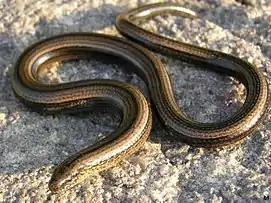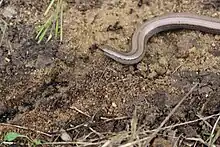Anguis
Slowworms[3] (also called blindworms and hazelworms) are a small genus (Anguis) of snake-like legless lizards in the family Anguidae. The genus has several living species, including the common slowworm, the eastern slowworm, the Greek slowworm, the Peloponnese slowworm, and the Italian slowworm (Anguis veronensis). There are also known fossil species.
| Anguis Temporal range: | |
|---|---|
 | |
| Anguis fragilis | |
| Scientific classification | |
| Domain: | Eukaryota |
| Kingdom: | Animalia |
| Phylum: | Chordata |
| Class: | Reptilia |
| Order: | Squamata |
| Family: | Anguidae |
| Subfamily: | Anguinae |
| Genus: | Anguis Linnaeus, 1758[2] |
| Type species | |
| Anguis fragilis Linnaeus, 1758 | |
| Species | |
| |
 | |
Description
Slowworms are typically grey-brown, with the females having a coppery sheen and two lateral black stripes, and the males displaying electric blue spots, particularly in the breeding season. They give birth to live young, which are about 4 cm (1.6 in) long at birth and generally have golden stripes.
Slowworms are slow-moving and can be easily caught, which has given rise to the folk etymology that the "slow" in slowworm is the same as the English adjective slow; the actual origin is a proto-Germanic root which simply means "slowworm" (cf. German Schleiche).[3] Like many lizards, slowworms can shed their tails to distract predators. The tail regrows, but never fully.[4] Principal predators are birds, badgers, hedgehogs, foxes and domestic cats.[5][6][7]
The average British slowworm can grow to 45 cm when fully mature and weigh about 100 g, females being slightly larger than the males. The tail makes up around half its length, but is indistinguishable from the body. It has been recorded to live for up to 30 years in wild, and the record age for a slowworm in captivity is 54 years (Copenhagen Zoo).
The specific name fragilis (fragile) comes from the tendency of this species to shed its own tail, when threatened by predators, or if handled too roughly (caudal autotomy).
Morphology
Although slowworms much resemble snakes, and are often mistaken for such, they are actually lizards that have lost their limbs completely with evolution.
Slowworms can be distinguished from snakes by several features: their eyelids, which snakes lack (having brille instead); their small ear openings, which again snakes lack; and their tongues, which are notched in the centre rather than completely forked like a snake's. Further, snakes have an opening in their upper jaw to allow their tongue through, which slowworms lack.[8]
Habitat
Slowworms live in any habitat that is warm and protected, such as woodland, grassland, and heathland; they are frequently found in garden compost heaps, sometimes on purpose for pest control.[7] They range across most of Europe, and into parts of Asia, but they are restricted to temperate and humid habitats. They hibernate from October to February/March, both communally and solitarily, and sometimes share hibernating sites with other reptiles.
Diet
Slowworms have grooved teeth which allow them to grab and swallow whole their soft invertebrate prey, such as slugs, hairless caterpillars, other insects, spiders, and earthworms.[9] Snails are usually avoided, except when they are still very young and the shell can be broken easily.
Protected status
Slowworms are protected in the United Kingdom and Poland.
Classification
Subfamily Anguinae
- Genus Anguis
- Anguis cephallonica, Peloponnese slowworm – Werner, 1894[10]
- Anguis colchica, eastern slowworm – (Nordmann, 1840)
- Anguis fragilis, common slowworm — Linnaeus, 1758[11]
- Anguis graeca, Greek slowworm – Bedriaga, 1881
- Anguis veronensis, Italian slowworm — Pollini, 1818[12]
- †Anguis rarus Klembara & Rummel, 2017[1]
- †Anguis stammeri Brunner, 1957[1]
- †Anguis polgardiensis Bolkay, 1913[1]
Gvoždík et al. (2013) distinguished five genetic species of Anguis: graeca, colchica, fragilis, cinerea, and cephallonica, but a review of the genus has not yet been completed.[13]
Extant species
| Image | Scientific name | Common name | Distribution |
|---|---|---|---|
 | Anguis cephallonica | Peloponnese slowworm | southern Greece |
 |
Anguis colchica | eastern slowworm | eastern Europe, the Caucasus, and northern Anatolia and Iran |
 | Anguis fragilis | common slowworm | western, central, and parts of southeastern Europe |
 |
Anguis graeca | Greek slowworm | Greece, Albania, and Macedonia |
 | Anguis veronensis | Italian slowworm | Italy and southeastern France[14] |
References
- Jozef Klembara; Michael Rummel (2018). "New material of Ophisaurus, Anguis and Pseudopus (Squamata, Anguidae, Anguinae) from the Miocene of the Czech Republic and Germany and systematic revision and palaeobiogeography of the Cenozoic Anguinae". Geological Magazine. 155 (1): 20–44. Bibcode:2018GeoM..155...20K. doi:10.1017/S0016756816000753. S2CID 132414700.
- ITIS.gov
- The "slow-" in slowworm is distinct from the English adjective slow ("not fast"); the word comes from Old English slāwyrm, where slā- means "slowworm" and wyrm means "serpent, reptile". ("Slowworm". The American Heritage Dictionary of the English Language. Houghton Mifflin Harcourt. 2017.)
- "RSPB - Wildlife Garden A to Z". Retrieved 30 May 2014.
- "Wild about gardens - Slow worm". Archived from the original on 8 February 2013. Retrieved 30 May 2014.
- "Wildlife Watch - Beast of the month". Archived from the original on 30 May 2014. Retrieved 30 May 2014.
- "The Wildlife Trusts - Slow worm". Retrieved 30 May 2014.
- Duncan, James. "Species of the day: Slow-worm". Sussex Wildlife Trust. Sussex Wildlife Trust. Retrieved 19 May 2023.
- "RSPB - Ask an expert". Retrieved 30 May 2014.
- iucnredlist.org - Anguis cephalonnica
- Herpetofauna.co.uk
- Renet, Julien; Lucente, Daniela; Delaugerre, Michel; Gerriet, Olivier; Deso, Grégory; Abbattista, Chiara; Cimmaruta, Roberta (2018). "Discovery of an Italian slow worm (Anguis veronensis Pollini, 1818) population on a Western Mediterranean Island confirmed by genetic analysis". Acta Herpetologica. 13 (2): 165–169. doi:10.13128/Acta_Herpetol-23290.
- "Anguis graeca".
- Speybroeck, Jeroen; Beukema, Wouter; Dufresnes, Christophe; Fritz, Uwe; Jablonski, Daniel; Lymberakis, Petros; Martínez-Solano, Iñigo; Razzetti, Edoardo; Vamberger, Melita; Vences, Miguel; Vörös, Judit; Crochet, Pierre-André (2020). "Species list of the European herpetofauna – 2020 update by the Taxonomic Committee of the Societas Europaea Herpetologica". Amphibia-Reptilia. 41 (2): 139–189. doi:10.1163/15685381-bja10010.